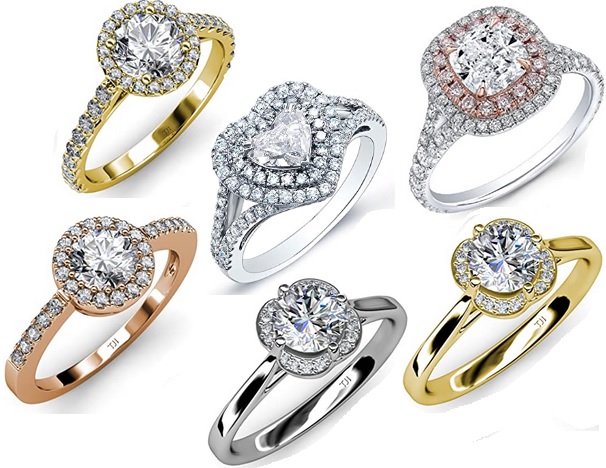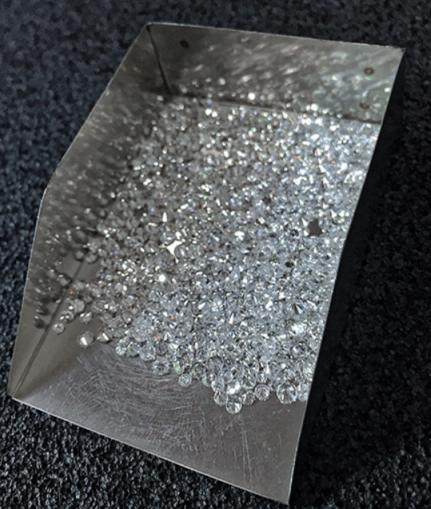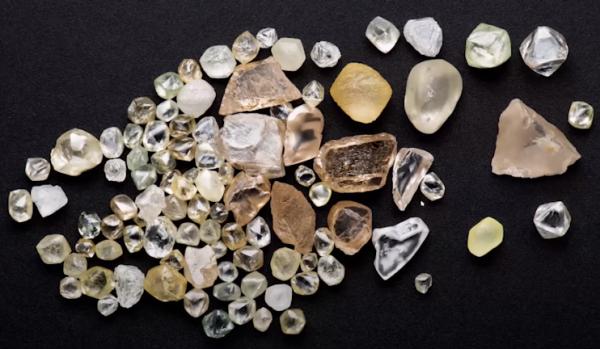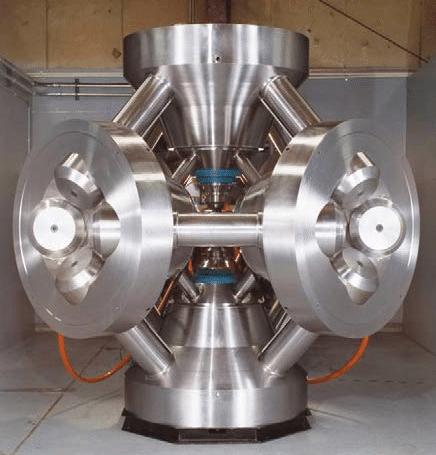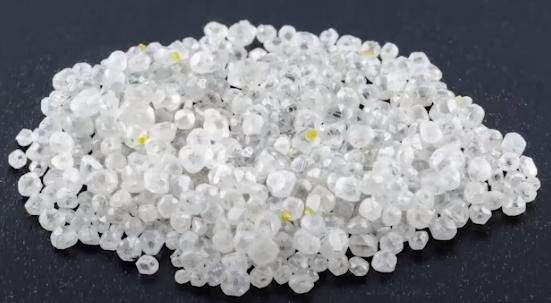Detecting HPHT Diamond Melee : A Detailed Analysis.
Melee diamonds are among the smallest of diamonds. For this reason, many in the gem trade consider them to be inconsequential. However, these days, it has become particularly important to understand and identify these mini diamonds.
Understanding melee diamonds has become immensely important because of the increasing number of lab-grown diamonds being introduced in the marketplace. More so because melee diamonds are tiny. And tiny lab created diamonds are tricky to identify and separate.
The biggest and brightest colored diamonds are the usual favourites to talk about. But today, let us discuss just the opposite. Let us talk about the microminiature melee diamonds.
Look at the jewelry images below.
Diamond Melee Halo Rings
You find your attention focussed on the larger vibrant gemstones. The center stones are the cynosure of your eyes. Your eyes virtually ignore the supporting cast of surrounding stones (the melee) even though they add a lot of sparkle to the jewels. Take away the melee and you take away a lot of sparkle. It will also seem to subtract from the beauty of the centre stone.
So what are melee diamonds? They are very small faceted diamonds weighing less than 1/5 carat. They can be as small as 0.001 ct.
Melee Diamonds
These diamonds are usually (though not always) cut into tiny round diamonds. Earlier when they were cut and polished by hands they were given 17 to 18 facets only. Handling the tiny diamonds by hand was extraordinarily difficult and ticklish. With the advent of technology and machine cutting it has become possible to cut the melee into modern round brilliants with 57 to 58 facets just like the larger stones.
And just like the larger stones it is also imperative to know whether these small diamonds are natural or lab-grown.
Please see the collection of natural diamonds in the image below.
Rough for Natural Melee Diamonds
You can see a nice mix of diamonds of different sizes and colors. You can see a few large stones. But you can also see a number of small octahedral diamond crystals. It is evident that you cannot cut large diamonds out of these. You can either cut one small stone or a couple of small stones out of each of them. These are the source of natural melee diamonds. Melee diamonds can also be carved from cuttings of larger diamonds. Needless to say that natural melee diamonds come out of mines.
We all know that diamonds are now increasingly being grown in labs replicating the environment of nature. In nature, diamonds grow when carbon is subjected to a pressure of 5 to 6 gigapascals. This happens at a depth of 150 to 200 kilometers. Also the temperature should be around 1000 degrees celsius.
Similar high pressure, high temperature conditions are created in labs to create man-made diamonds. However, the temperature is kept higher to speed up the process so that we don’t have to wait for millions of years.
The first Chemical Vapor Deposition (CVD) diamond was made long back in 1952 by William Eversol at union carbide.
Soon after that, a Swedish company, ASEA, grew the high pressure high temperature (HPHT) synthetic diamond in 1953. They chose to keep their achievement a secret.
On the other hand, scientists at General Electric including Tracy Hall announced with great flourish in 1954 that they had discovered the correct mix of heat, pressure and carbon flux to make diamonds in a laboratory.
General Electric indulged in trials, errors and experiments for sixteen more years before pioneering its first gem quality high pressure high temperature lab-grown diamond in 1970. Research continued in this field and eventually large lab grown diamonds appeared in the market by the year 2015.
What happened in the next couple of years was incredible. By 2017, copious quantities of minute melee diamonds to the tune of hundreds of thousands of carats per month started emerging mainly from China. And production is still more plentiful today.
Tiny diamonds were grown in the past too. But it had been virtually impossible to grow colorless or near colorless ones. That was the real breakthrough.
So let us discuss the growth techniques in brief. The high pressure high temperature method tries to recreate the diamond creating conditions inside earth. Accordingly pressure is kept at around six gigapascals mimicking pressures at the depths of 150 to 200 kms of earth’s interiors. However, temperature is kept at around 1600 degrees celsius. This is a few hundred degrees higher than what it is inside earth. Higher temperature accelerates diamond growth.
A reaction vessel inside a “belt” type apparatus mounted in a high-pressure hydraulic press achieves the required high pressure. The temperature inside the vessel is also carefully controlled.
Cubic Press For Generating Pressure And Temperature For HPHT Diamonds
A metal solvent catalyst is used as a flux to aid the movement and transfer of carbon from the carbon-source down to the seed for growth. Carbon is contributed by a material such as graphite. This Carbon dissolves in the molten flux consisting of metals such as iron (Fe), nickel (Ni) or cobalt (Co). A temperature gradient is also required to be maintained inside the chamber. The bottom region is relatively cooler while the top regions are at a relatively higher temperature. Consequently, the carbon migrates and crystallizes around the seed crystal. This technique is known as “temperature gradient” or “reconstitution” technique. A one carat diamond grows in around seven days using this technique.
Lab grown melee diamonds for industrial use are grown in a slightly different manner. So what is different in the recipe for growing the tiny diamonds?
Firstly, we don’t have to use a seed crystal at the bottom of the hydraulic press. The carbon spontaneously crystallizes all around the chamber and makes numerous diamonds. We just need smallish crystals to develop. And they just nucleate and mushroom all around the growth-chamber. However, the iron-nickel-cobalt metals solvent/catalyst has to be used in this case too.
You will be amazed to know that one cycle of such a diamond creation is complete within an hour. So you can imagine that thousands of kilos of such material are produced annually. And most of it comes from China.
Colorless HPHT Melee Diamonds
The puny diamonds thus created are modestly priced. They are sold at as low as 12 cents per carat. But they are true diamonds after all. And their unparalleled properties make them a proper material for various cutting-edge scientific and industrial applications. The diminutive pebbles are put to a number of commercial uses. They are coated on wire saws, saw-blades, diamond drill bits, medical scalpels et al.
When grown to somewhat larger sizes, they are used as gemstones in jewelry. However, if they are to be used as gemstones, the process has to be controlled carefully to prevent nitrogen atoms from fusing into the diamond crystal structure. This is because nitrogen imparts an undesirable yellow color to the stones.
Under very high magnification you can discern the distinctive cube octahedral crystal shape of the stones. This is the classic crystal shape for high pressure high temperature lab grown diamonds.
With repeated high volume production of diamonds the technique kept refining. Very soon, somebody developed the knack to grow colorless variants of the tiny stones. Ironically, seed crystals used to develop these colorless versions are the minute yellow industrial diamonds. And frequently umbilical vestige of the tiny yellow seed can still be seen attached to the finished larger colorless stone. The larger stones are cut into faceted melee. The production of faceted melee by the HPHT method is to the tune of hundreds of thousands of carats per month. Do you get the point? There are a lot of HPHT lab grown melee diamonds in circulation.
Another major lab-growth technique is the Chemical Vapor Deposition method popularly known as CVD. This is a more complex method than HPHT.
It comprises a sealed reaction chamber kept under vacuum. A sliver of a diamond seed is placed inside the chamber. The chamber is then heated upto around 800 degrees celsius. Carbon rich methane gas mixed with hydrogen is released into the chamber. High energy microwaves or lasers ionize these gases into their plasma state. Upon ionization, the inter-molecular bonds of the gases weaken and break. Consequently, pure carbon is set free. Methane contributes the free carbon. Hydrogen is the cleaning agent.
The freed carbon starts adhering to the diamond seed. Hydrogen does the housekeeping by etching away any non-diamond carbon. The seed swells into a larger diamond with every additional layer of crystallized carbon deposited on it.
The CVD technique has some intrinsic advantages over the HPHT. The temperature and pressures needed are much lower as compared to HPHT. By this method, diamonds can be grown on larger areas by using a larger diamond seed plate. You have a finer control over the environment inside the growth chamber. Therefore, you can better control the quality of the diamond. However, you cannot grow larger diamonds by this technique. The largest diamond grown by this process till date is only 3.23 carats.
It is pertinent to say that though diamonds produced by this method are relatively small in size, tiny melee diamonds are seldom created using this method because it is not cost effective.
Advancement in technique, particularly by China has made it easy and cost-effective to produce melee diamond by the HPHT method. So the man-made melee floating in the market is mostly the yield of HPHT.
So, we have finally arrived at the crux of this entire discussion. How do you identify and separate the lab created melee diamonds from the natural ones?
When you are grappling with stones of such small sizes, you have to cope with the problems that come with small sizes.
Whether mounted or loose, their small size makes it virtually impossible to peer into them and look for inclusions. For the same reason, analytical instruments do not find enough sample material to do the analysis. Moreover, you can only appreciate the pain of handling these pintsized stones when you handle them yourselves. It is ridiculously easy to lose one. They can literally be gone with the wind.
What’s more it takes a lot more time to analyze one of these miniature diamonds than it would take for a larger size diamond of say half a carat. At the same time the smaller stones carry much less value. So you have to decide whether detecting HPHT diamond melee is worth the time taken to analyze them in the first place.
So how do we recognize lab-grown diamonds? While going through some of the methods of this analysis, we will also come to terms with the difficulties encountered in ascertaining lab-origins of melee diamonds. And this will be more about stones obtained from the HPHT method. It is because most of the men-made melee circulating today owe their origins to the HPHT method.
Studying Diamond Fluorescence For Detecting HPHT Diamond Melee:
Natural diamonds have a distinctly different pattern of crystallization than their lab grown counterparts. Natural diamond crystals form as octahedrons. On the other hand, HPHT synthetic diamond crystals retain cubic faces in conjunction with octahedral ones. This difference in crystal shapes leads to a dramatic difference in the internal growth patterns of respective crystals. This difference in growth patterns is among the most reliable ways to distinguish between natural and lab-created diamond crystals.
Due to the typical growth pattern of HPHT diamonds, different regions inside the diamonds incorporate impurities (like boron and nitrogen) in different quantities. This leads to segregation of impurities across different zones.
As a further consequence, the regions fluoresce differently. The study of ultraviolet fluorescence is a key diagnostic tool for distinguishing HPHT-grown synthetics from natural diamonds. The determination is based on differences in fluorescence colors, intensities, and patterns
Here are four views of fluorescence of a 0.43 ct blue synthetic diamond. You can see the pattern of fluorescent and nonfluorescent growth sectors. And the pattern shifts as the sample is rotated.
Synthetic Diamond Fluorescence
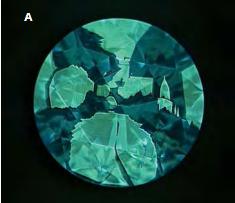
The face-up view (A) shows the four-fold, cross-shaped fluorescence pattern typical of HPHTgrown synthetic diamonds. However, in this orientation, the display shows a somewhat convoluted arrangement of growth sectors.
Synthetic Diamond Fluorescence B
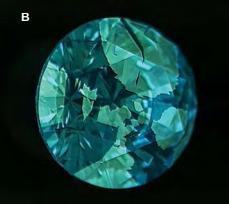
As you rotate the sample toward the pavilion (B and C), the pattern of growth structure assumes a more regular structure.
Synthetic Diamond Fluorescence C
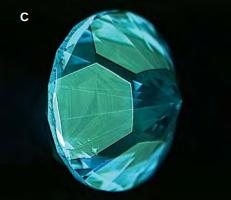
In the pavilion views (C and D), fine growth striations arising out of subtle variations in impurity contents start becoming visible . You have these squares and sort of arms coming off the corners of the squares.
Synthetic Diamond Fluorescence D
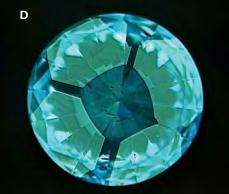
In larger diamonds like the above, you are able to see the growth sectors clearly. But the melee diamonds are so small that you will be unable to discern the unique cube-octahedral fluorescence patterns. So using this method for detecting HPHT diamond Melee is well-nigh impossible.
Studying Diamond Phosphorescence For Detection:
So let us discuss another way of identifying HPHT lab grown diamonds. It is by studying phosphorescence exhibited by these diamonds.
Shine ultraviolet light from a shortwave UV LAMP onto a stack of melee diamonds for some time in a darkened room. After you switch off the lamp, the stack keeps glowing with the afterglow of phosphorescence. It occurs because of the presence of trace quantities of boron. And this is not a unique property of HPHT diamonds.
HPHT Melee Diamonds Phosphorescence
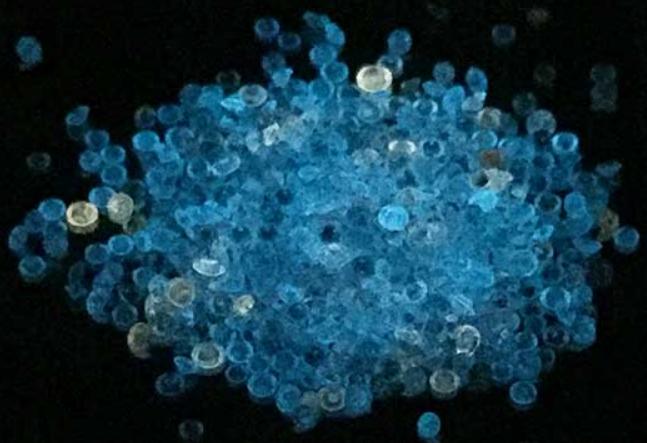
Yet, natural diamonds rarely show any phosphorescence. When they do show it, the phenomena is fleeting. It extinguishes quickly in one or two seconds. On the other hand, HPHT diamonds can phosphoresce upto 50 seconds which is almost a minute.
The difference in length of phosphorescence time makes it a very handy tool for identifying an HPHT diamond. However, nature, strength and duration of phosphorescence may differ with different manufactures.
It is very pertinent to point out that some HPHT diamonds when exposed to radiation lose their phosphorescence. At room temperature, they do not phosphoresce even after getting exposed to ultraviolet light.
Moreover, the very rare and expensive natural type 2b diamonds contain Boron. Evidently, such natural diamonds also phosphoresce owing to the presence of Boron. One should not mistake them to be HPHT diamonds because of their phosphorescence. It would be a massive blunder as natural type II diamonds are extraordinarily rare and exorbitantly expensive.
We realize that there are many obstacles in using phosphorescence to identify HPHT diamonds. Also, we comprehend that though phosphorescence is a good tool, it is not completely reliable.
Studying Diamond Inclusions For Detecting HPHT Diamond Melee:
One more method of recognizing HPHT diamonds is by scrutinizing their inclusions. While the diamonds are growing in the lab, tiny metallic tit-bits get trapped as inclusions inside the diamonds. The grainy remnants are residues from the iron-cobalt-nickel catalyst used as metallic flux in the growth process.
The inclusions are shiny micro misshapen bits of metals. Then again, you can never be sure whether they are leftovers from a lab or natural graphitized crystals particularly when the diamond is as small as a melee.
Reputed Hi-Fi labs do have sophisticated instruments like scanning electron microscopes. Experienced scientists can peer closely at the inclusions through such instruments. They can guage the chemistry of the inclusions and ascertain whether they are made of iron-nickel-cobalt. Presence of this metal combination would give away that the diamond is lab created as it does not occur in natural diamonds.
However, not everyone has access to such advanced and expensive instruments. And it brings us back to the original question. Is it worth the time, money and effort to identify such inexpensive stones as lab-created melee?
Studying Magnetic Attraction of Diamonds For Detecting HPHT Diamond Melee:
One more interesting way to identify smaller HPHT diamonds like the melee is through magnetism. Iron forms the highest concentration in the metallic mix flux used in HPHT method. As such, the inclusions in HPHT diamonds have the highest proportion of iron.
Further, melee diamonds being very small and practically weightless, they get easily attracted to a strong magnet. At times, you can attract the stones with a magnet and separate them. But, more often than not, this does not work. It is because diamonds usually do not carry enough inclusions to be attracted by a magnet.
On the rare occasion when the melee does get attracted to a magnet, you can say with a high degree of certainty that it is an HPHT diamond.
One more thing that cannot be left un-discussed is that melee diamonds almost always come mounted on jewelry in clusters. You cannot take them off their mountings and you cannot test them while they are mounted. And if you use fluorescence and phosphorescence for identification, you risk mid-identifying a type IIB natural diamond to be an HPHT diamond.
This Miniature Stones Can be Different Shapes and Colors:
Further, don’t let the shape of the stone fool you. Though most of them are round brilliants, melees are cut into all sorts of fancy shapes as well. They can be cut into tapered baguette or baguette. Likewise, melee can be colored diamonds too. Beautiful yellow and pink melee diamonds are easily available in the jewelry business. So don’t assume that because a melee diamond is fancy shape or fancy color, it is a natural diamond.
We have seen a lot of tests and processes done to identify lab-grown diamonds in general and HPHT diamonds in particular. And we can conclude that identifying HPHT melee diamonds is a huge challenge.
All said and done, reputed labs like the GIA are equipped with the high tech instruments and manned by experts who can separate the wheat from the chaff. And mindful of the cost benefit ratio in case of melee diamonds the labs have made the services in case of melee diamonds identification less expensive. Yet, availing these services is seldom commercially justified.
More About Diamonds
